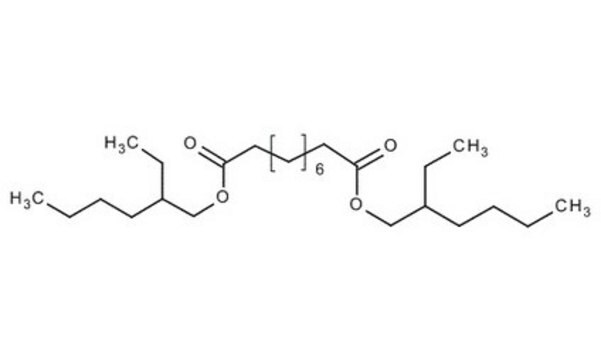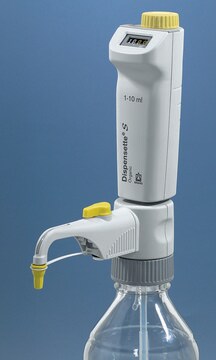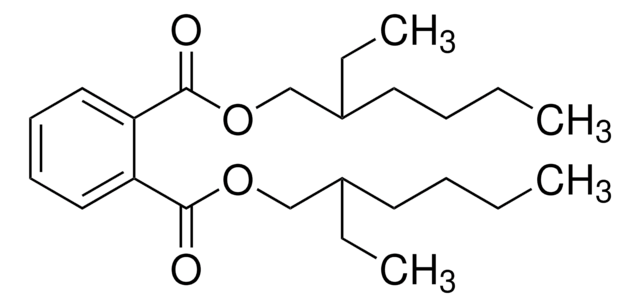Wszystkie zdjęcia(1)
Kluczowe dokumenty
About This Item
Wzór empiryczny (zapis Hilla):
C26H50O4
Numer CAS:
Masa cząsteczkowa:
426.67
Numer WE:
Numer MDL:
Kod UNSPSC:
12352200
Identyfikator substancji w PubChem:
Polecane produkty
Formularz
liquid
ciąg SMILES
CCCCCCCCOC(=O)CCCCCCCCC(=O)OCCCCCCCC
InChI
1S/C26H50O4/c1-3-5-7-9-15-19-23-29-25(27)21-17-13-11-12-14-18-22-26(28)30-24-20-16-10-8-6-4-2/h3-24H2,1-2H3
Klucz InChI
MIMDHDXOBDPUQW-UHFFFAOYSA-N
Inne uwagi
Please note that Sigma-Aldrich provides this product to early discovery researchers as part of a collection of unique chemicals. Sigma-Aldrich does not collect analytical data for this product. Buyer assumes responsibility to confirm product identity and/or purity. All sales are final.
NOTWITHSTANDING ANY CONTRARY PROVISION CONTAINED IN SIGMA-ALDRICH′S STANDARD TERMS AND CONDITIONS OF SALE OR AN AGREEMENT BETWEEN SIGMA-ALDRICH AND BUYER, SIGMA-ALDRICH SELLS THIS PRODUCT "AS-IS" AND MAKES NO REPRESENTATION OR WARRANTY WHATSOEVER WITH RESPECT TO THIS PRODUCT, INCLUDING ANY (A) WARRANTY OF MERCHANTABILITY; (B) WARRANTY OF FITNESS FOR A PARTICULAR PURPOSE; OR (C) WARRANTY AGAINST INFRINGEMENT OF INTELLECTUAL PROPERTY RIGHTS OF A THIRD PARTY; WHETHER ARISING BY LAW, COURSE OF DEALING, COURSE OF PERFORMANCE, USAGE OF TRADE OR OTHERWISE.
NOTWITHSTANDING ANY CONTRARY PROVISION CONTAINED IN SIGMA-ALDRICH′S STANDARD TERMS AND CONDITIONS OF SALE OR AN AGREEMENT BETWEEN SIGMA-ALDRICH AND BUYER, SIGMA-ALDRICH SELLS THIS PRODUCT "AS-IS" AND MAKES NO REPRESENTATION OR WARRANTY WHATSOEVER WITH RESPECT TO THIS PRODUCT, INCLUDING ANY (A) WARRANTY OF MERCHANTABILITY; (B) WARRANTY OF FITNESS FOR A PARTICULAR PURPOSE; OR (C) WARRANTY AGAINST INFRINGEMENT OF INTELLECTUAL PROPERTY RIGHTS OF A THIRD PARTY; WHETHER ARISING BY LAW, COURSE OF DEALING, COURSE OF PERFORMANCE, USAGE OF TRADE OR OTHERWISE.
Ta strona może zawierać tekst przetłumaczony maszynowo.
Kod klasy składowania
10 - Combustible liquids
Klasa zagrożenia wodnego (WGK)
WGK 3
Temperatura zapłonu (°F)
Not applicable
Temperatura zapłonu (°C)
Not applicable
Wybierz jedną z najnowszych wersji:
Certyfikaty analizy (CoA)
Lot/Batch Number
It looks like we've run into a problem, but you can still download Certificates of Analysis from our Dokumenty section.
Proszę o kontakt, jeśli potrzebna jest pomoc Obsługa Klienta
Masz już ten produkt?
Dokumenty związane z niedawno zakupionymi produktami zostały zamieszczone w Bibliotece dokumentów.
Klienci oglądali również te produkty
Moncef Tounsi et al.
Materials science & engineering. C, Materials for biological applications, 61, 608-615 (2016-02-04)
In this work, we describe the development of new Aza[7]helicene-containing PVC-based membranes for the K(+) ions quantification. Here, silicon nitride-based structures (Si-p/SiO2/Si3N4) were developed and the surface was activated, functionalized with an aldehyde-silane (11-(Triethoxysilyl)undecanal (TESUD)), functionalized with polypyrrole (PPy), and
Michelle O'Rourke et al.
Membranes, 1(2), 132-148 (2011-01-01)
Electrochemical impedance spectroscopy (EIS) has been used to estimate the non-frequency dependent (static) dielectric constants of base polymers such as poly(vinyl chloride) (PVC), cellulose triacetate (CTA) and polystyrene (PS). Polymer inclusion membranes (PIMs) containing different amounts of PVC or CTA
M M Khalil et al.
Scientific reports, 10(1), 8607-8607 (2020-05-27)
Novel multiwalled carbon nanotubes/ Fe-Co doped titanate nanotubes nanocomposite (MWCNTs/Fe-Co doped TNTs) facilitated the charge transfer and enhanced sensitivity and selectivity. Herein, three novel modified carbon paste sensors (CPSs) based on MWCNTs (sensor I), Fe-Co doped TNTs (sensor II) and
Zafar Hussain Ibupoto et al.
Sensors (Basel, Switzerland), 13(2), 1984-1997 (2013-02-07)
In this research work, ZnO nanotubes were fabricated on a gold coated glass substrate through chemical etching by the aqueous chemical growth method. For the first time a nanostructure-based iodide ion selective electrode was developed. The ZnO nanotubes were functionalized
Eman Y Z Frag et al.
International journal of analytical chemistry, 2011, 604741-604741 (2011-10-21)
This study compares between unmodified carbon paste (CPE; the paste has no ion pair) and polyvinyl chloride (PVC) membrane selective electrodes that were used in potentiometric determination of ketotifen fumarate (KTF), where sodium tetraphenylborate (NaTPB) was used as titrant. The
Nasz zespół naukowców ma doświadczenie we wszystkich obszarach badań, w tym w naukach przyrodniczych, materiałoznawstwie, syntezie chemicznej, chromatografii, analityce i wielu innych dziedzinach.
Skontaktuj się z zespołem ds. pomocy technicznej








